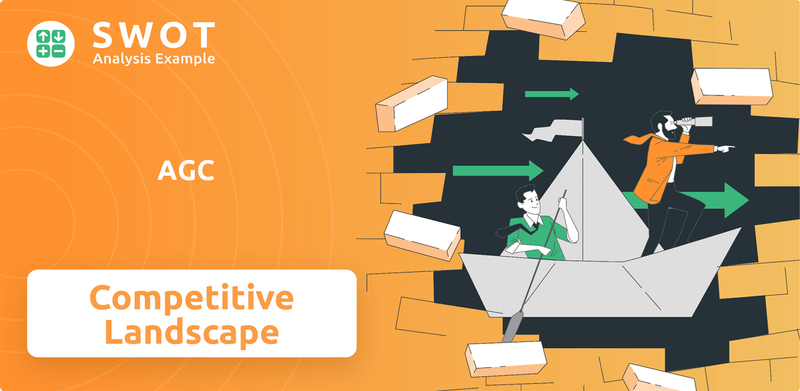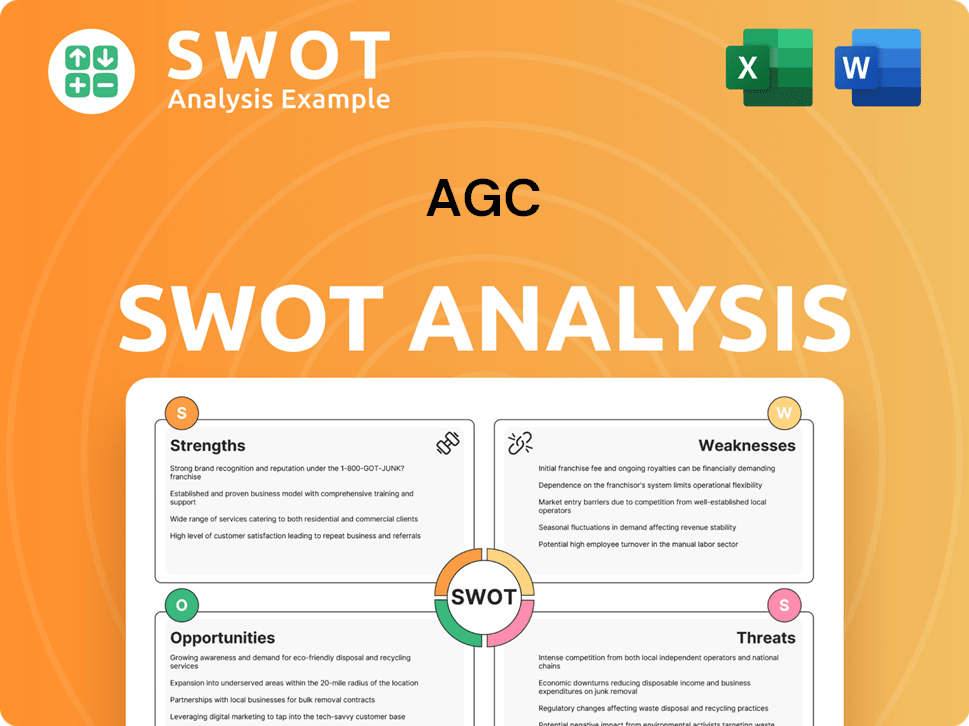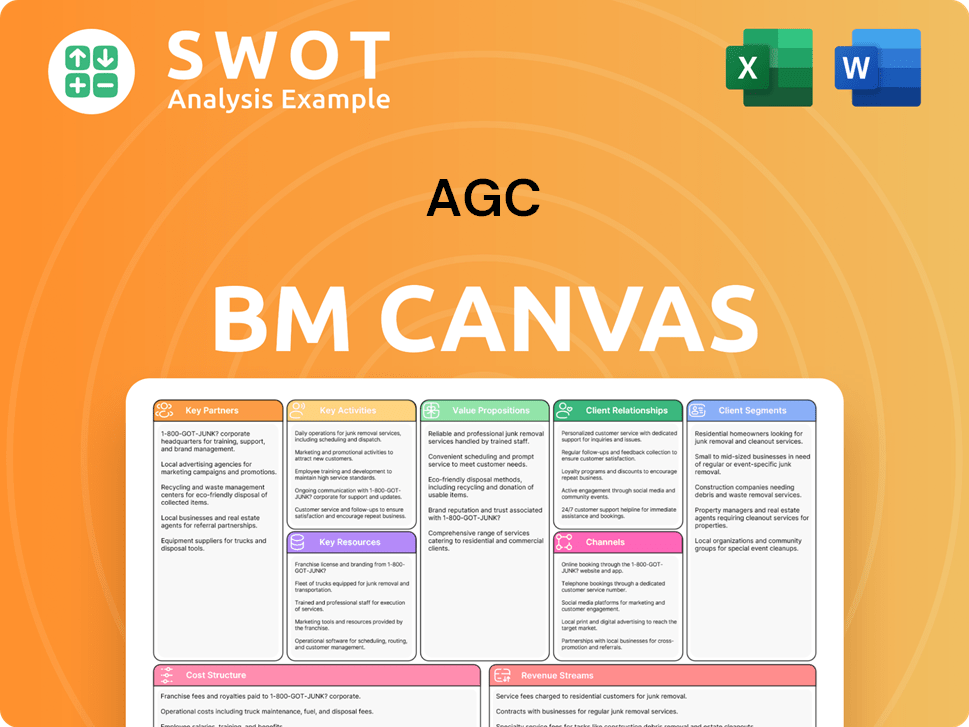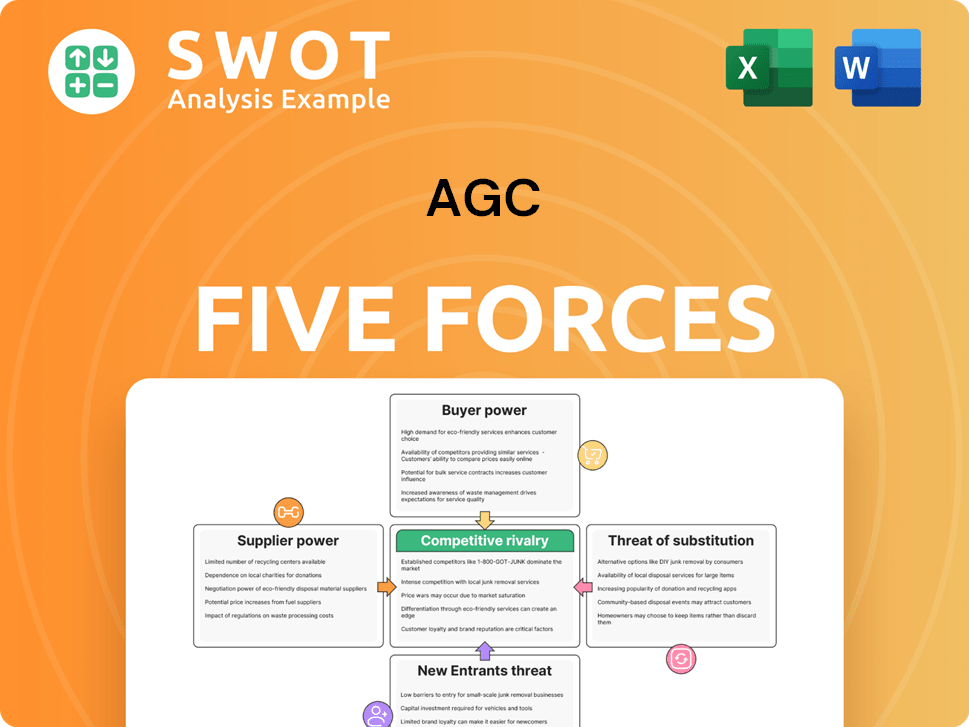AGC Bundle
Can AGC Inc. Maintain Its Global Leadership?
In today's dynamic market, understanding the AGC SWOT Analysis is crucial. AGC, a titan in glass, chemicals, and high-tech materials, faces a complex and ever-shifting competitive landscape. This analysis will dissect AGC's strategic positioning, exploring its strengths, weaknesses, opportunities, and threats within the AGC industry.

This deep dive into the AGC competitive landscape will identify key AGC competitors and evaluate their impact. We'll conduct a thorough AGC market analysis, examining AGC's business strategy and its ability to navigate challenges like fluctuating raw material costs and evolving customer demands. Furthermore, we'll explore questions like: How does AGC compare to Saint-Gobain and other rivals in the AGC glass market? What are AGC's strategies to maintain market leadership?
Where Does AGC’ Stand in the Current Market?
The company, a global leader in glass and materials science, holds a significant market position across its diverse segments. Its core operations involve manufacturing and supplying glass products for various industries, including construction, automotive, and electronics. The company's value proposition lies in its ability to provide high-quality, innovative glass solutions that meet the evolving needs of its customers worldwide. This is reflected in its strong market presence and its commitment to technological advancements.
In the flat glass market, the company is a top global player, with a strong presence in architectural and solar applications. For automotive glass, it holds a substantial share, serving major car manufacturers globally. The company is also a leading supplier in the display glass market, crucial for smartphones, tablets, and televisions. The company's strategic focus on high-performance and specialty products, along with digital transformation initiatives, enhances its operational efficiency and customer engagement. You can find more details about the company's origins in this Brief History of AGC.
The company's financial health reflects a stable and large-scale operation. With a reported revenue of JPY 2,010.5 billion in 2023, the company demonstrates its significant market presence. The company's geographic presence spans across Asia, Europe, North America, and South America, with a strong manufacturing and sales network. Its customer segments are broad, encompassing construction companies, automotive original equipment manufacturers (OEMs), electronics manufacturers, and healthcare providers.
The company consistently ranks among the top global players in its core areas, including architectural, automotive, and display glass. Its strong market position is supported by its extensive product portfolio and global presence. The company's competitive advantages include its technological expertise and its ability to meet diverse customer needs.
The company operates within the glass manufacturing industry, which is characterized by intense competition and rapid technological advancements. Key trends include the growing demand for energy-efficient glass, lightweight automotive glass, and advanced display glass. The company's strategic focus on innovation and sustainability positions it well for future growth.
The company's business strategy involves a focus on high-performance and specialty products, along with digital transformation initiatives. It aims to expand its market reach, particularly in emerging markets, and strengthen its partnerships. The company's strategic alliances and investments in research and development support its long-term growth objectives.
The glass market is highly competitive, with various players vying for market share across different segments. The company faces competition from both global and regional players. The company's ability to innovate and adapt to changing market demands is crucial for maintaining its competitive edge.
The company's competitive landscape includes major players in the glass industry. The company competes with companies like Saint-Gobain and others in various segments. The company's market share varies by segment, but it consistently ranks among the top competitors globally, especially in architectural, automotive, and display glass.
- The company's main rivals in the automotive glass sector include major global manufacturers.
- The company's market share worldwide is significant, with a strong presence in key regions like Asia and Europe.
- Competitive advantages of the company include its technological expertise, global presence, and diverse product portfolio.
- The company's position in the architectural glass market is very strong due to its innovative products.
AGC SWOT Analysis
- Complete SWOT Breakdown
- Fully Customizable
- Editable in Excel & Word
- Professional Formatting
- Investor-Ready Format

Who Are the Main Competitors Challenging AGC?
The Owners & Shareholders of AGC face a complex competitive landscape. This landscape is shaped by a variety of factors, including the specific market segments in which AGC operates, the geographic regions it serves, and the evolving technological advancements in the glass industry. Understanding the competitive dynamics is crucial for assessing AGC's market position and future prospects.
AGC's competitive environment is characterized by both direct and indirect competition. Direct competitors offer similar products and services, while indirect competitors may provide alternative solutions or materials. This analysis will delve into the key players, their strengths, and how they impact AGC's business strategy.
The competitive landscape for AGC is dynamic, influenced by global market trends, technological innovations, and strategic moves by key players. A thorough understanding of these factors is essential for evaluating AGC's performance and future growth potential. The following sections provide a detailed look at AGC's main competitors and the competitive dynamics within the industry.
In the flat and automotive glass sectors, AGC faces strong competition from established global players. These competitors have significant market share and extensive resources. The competitive pressure drives innovation and efficiency within the industry.
Saint-Gobain is a major competitor, particularly in architectural and automotive glass. The company's strong presence in Europe and diverse product portfolio pose a significant challenge to AGC. Saint-Gobain's global reach and established brand recognition are key competitive advantages.
NSG Group (Pilkington) is another major player, especially in automotive and architectural glass. NSG is known for its advanced glass technologies and strong market presence. The company's focus on innovation and quality makes it a formidable competitor.
Fuyao Glass Industry Group is a rapidly expanding Chinese company, especially in the automotive glass sector. Its cost-effectiveness and increasing global reach make it a significant competitor. Fuyao's aggressive expansion strategy has reshaped the competitive landscape.
In the display glass market, AGC competes with companies that specialize in high-tech glass products. These competitors often focus on innovation and advanced materials. The display glass market is driven by the consumer electronics and technology sectors.
Corning is a dominant player in specialty glass, particularly for consumer electronics with its Gorilla Glass. Continuous innovation and strong brand recognition are key competitive advantages. Corning's focus on research and development keeps it at the forefront of the industry.
Schott AG is known for its high-quality specialty glass and glass-ceramics, competing in niche high-tech display applications. Schott's expertise in specialized glass products allows it to serve specific market segments. The company's focus on quality and innovation is a key differentiator.
Beyond direct competitors, AGC faces indirect competition from alternative materials and evolving technologies. The industry is also influenced by mergers, alliances, and new entrants. Understanding these broader market dynamics is crucial for strategic planning.
- Alternative Materials: Advancements in lightweight composites and smart materials in construction can impact demand for traditional glass.
- Technological Advancements: New technologies and innovations continuously reshape the competitive landscape.
- Mergers and Alliances: Consolidations in the chemical industry and other sectors can alter competitive dynamics.
- New Entrants: Emerging economies and new business models can disrupt the traditional market structure.
AGC PESTLE Analysis
- Covers All 6 PESTLE Categories
- No Research Needed – Save Hours of Work
- Built by Experts, Trusted by Consultants
- Instant Download, Ready to Use
- 100% Editable, Fully Customizable

What Gives AGC a Competitive Edge Over Its Rivals?
Understanding the competitive advantages of AGC is crucial for a comprehensive AGC competitive landscape analysis. These advantages are multifaceted, stemming from its robust research and development (R&D) capabilities, proprietary technologies, and a strong global operational footprint. The company's strategic positioning in various markets, including automotive, architectural, and specialty glass, is a key factor in its sustained success.
The company's competitive edge is further enhanced by its brand equity and customer loyalty, cultivated over more than a century. AGC's reputation for quality and innovation fosters strong relationships with its global client base, particularly in the automotive and electronics industries. This reputation, combined with its extensive distribution networks and integrated supply chain, ensures timely delivery and efficient service worldwide, solidifying its market position.
A deep dive into AGC market analysis reveals how the company leverages its strengths. AGC's business strategy focuses on high-value-added products and solutions, allowing it to maintain a competitive edge in a dynamic market. Continuous investment in innovation and strategic foresight is essential for sustaining these advantages against rapid technological imitation and evolving industry standards.
AGC's extensive R&D capabilities and proprietary technologies provide a significant barrier to entry. The company holds a vast portfolio of patents in glass formulations, coatings, and manufacturing processes. For example, its specialized glass for automotive displays highlights its technological lead in high-value segments.
Built over more than a century, AGC's brand equity and customer loyalty are crucial assets. The company's reputation for quality, reliability, and innovation fosters strong relationships with its global client base. This is particularly evident in the automotive and electronics industries, where long-term partnerships are common.
AGC's vast production capacities worldwide enable cost efficiencies in manufacturing and procurement. Its extensive distribution networks and integrated supply chain capabilities ensure timely delivery and efficient service globally. The company's diverse talent pool continuously drives product development and process innovation.
Economies of scale, derived from its vast production capacities worldwide, allow for cost efficiencies in manufacturing and procurement. This makes AGC competitive on price for high-volume products. These efficiencies are crucial for maintaining market share in a competitive landscape.
The competitive advantages of AGC are multi-faceted, including technological leadership, brand strength, and a global presence. Understanding these strengths is vital for investors and strategists alike. For a deeper dive into the company's marketing strategies, consider reading about the Marketing Strategy of AGC.
- Extensive R&D and Patent Portfolio: AGC holds a vast portfolio of patents in glass formulations, coatings, and manufacturing processes.
- Strong Brand Reputation: AGC's reputation for quality, reliability, and innovation fosters strong customer relationships.
- Global Production and Distribution: AGC's worldwide production facilities and distribution networks ensure efficient service.
- Economies of Scale: Large-scale production allows for cost efficiencies, making AGC competitive on price.
AGC Business Model Canvas
- Complete 9-Block Business Model Canvas
- Effortlessly Communicate Your Business Strategy
- Investor-Ready BMC Format
- 100% Editable and Customizable
- Clear and Structured Layout

What Industry Trends Are Reshaping AGC’s Competitive Landscape?
The competitive landscape for AGC Inc. is currently shaped by technological advancements, regulatory changes, and shifting consumer preferences. The automotive industry's shift towards electric vehicles (EVs) and autonomous driving presents both challenges and opportunities for AGC. The construction sector's increasing demand for energy-efficient solutions aligns with AGC's focus on high-performance architectural glass, impacting the AGC competitive landscape.
Regulatory changes, particularly those related to environmental sustainability, are driving demand for greener manufacturing processes. Global economic shifts, including supply chain disruptions and inflationary pressures, continue to impact production costs and market demand. Potential threats include intensified competition from emerging players, especially from Asia, and the rapid pace of material science innovation. To understand more about its business, you can read Revenue Streams & Business Model of AGC.
Technological advancements, particularly in the automotive and construction sectors, are driving innovation in glass products. The automotive industry's move towards EVs and autonomous vehicles requires specialized glass. The construction sector's demand for energy-efficient and smart glass solutions is also growing. These trends impact the AGC industry and its product development strategies.
Intensified competition from emerging players, especially in Asia, poses a significant challenge. The rapid pace of innovation in material science could lead to disruption from alternative materials. Economic factors, including supply chain disruptions and inflation, impact production costs and market demand. These challenges require strategic adaptation for AGC business strategy.
Emerging markets with growing infrastructure development and consumer electronics adoption offer significant growth potential. Product innovations, such as self-cleaning and electrochromic glass, provide substantial opportunities. Strategic partnerships with technology companies and startups can open new markets. These opportunities can help improve AGC market analysis and market reach.
AGC is likely to focus on high-value, specialized products and sustainable solutions. The company will deploy strategies focused on continuous R&D, strategic acquisitions, and diversification. This approach aims to maintain resilience and capture future growth. The company's responses will be crucial in the AGC competitive landscape.
AGC can leverage its expertise in eco-friendly materials and energy-saving glass solutions to meet regulatory demands. The company should focus on strategic partnerships and product innovations to expand its market reach. Continuous investment in R&D is crucial to stay ahead of the competition. These strategies are essential for AGC's long-term success.
- Eco-friendly materials and sustainable solutions.
- Strategic partnerships with technology companies.
- Continuous R&D and innovation in glass technology.
- Focus on high-value, specialized products.
AGC Porter's Five Forces Analysis
- Covers All 5 Competitive Forces in Detail
- Structured for Consultants, Students, and Founders
- 100% Editable in Microsoft Word & Excel
- Instant Digital Download – Use Immediately
- Compatible with Mac & PC – Fully Unlocked

Related Blogs
- What are Mission Vision & Core Values of AGC Company?
- What is Growth Strategy and Future Prospects of AGC Company?
- How Does AGC Company Work?
- What is Sales and Marketing Strategy of AGC Company?
- What is Brief History of AGC Company?
- Who Owns AGC Company?
- What is Customer Demographics and Target Market of AGC Company?
Disclaimer
All information, articles, and product details provided on this website are for general informational and educational purposes only. We do not claim any ownership over, nor do we intend to infringe upon, any trademarks, copyrights, logos, brand names, or other intellectual property mentioned or depicted on this site. Such intellectual property remains the property of its respective owners, and any references here are made solely for identification or informational purposes, without implying any affiliation, endorsement, or partnership.
We make no representations or warranties, express or implied, regarding the accuracy, completeness, or suitability of any content or products presented. Nothing on this website should be construed as legal, tax, investment, financial, medical, or other professional advice. In addition, no part of this site—including articles or product references—constitutes a solicitation, recommendation, endorsement, advertisement, or offer to buy or sell any securities, franchises, or other financial instruments, particularly in jurisdictions where such activity would be unlawful.
All content is of a general nature and may not address the specific circumstances of any individual or entity. It is not a substitute for professional advice or services. Any actions you take based on the information provided here are strictly at your own risk. You accept full responsibility for any decisions or outcomes arising from your use of this website and agree to release us from any liability in connection with your use of, or reliance upon, the content or products found herein.